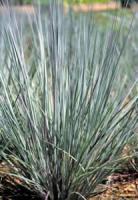Ornamental Grasses
The addition of ornamental grasses has become increasingly popular in recent years and is a great way of adding interest to the garden landscape. They can be grown quite easily from seed, but for the majority of people buying them in pots from a nursery will probably the route to take initially.
Many grass varieties also seed themselves quite happily, so you may find
them growing where they are not wanted. These should be dug up whilst
they are still small and planted in a more favorable position.
There
is a wide variety of grasses available, so you may wish to choose
several different varieties to begin with. Once they are growing
strongly you can propagate them through simple division if you need
more. The most effective time of year to split them up is during the
early spring before new growth emerges.
If you purchase your
plants during the early springtime, you may be in a position to divide
them straight away. However, should you purchase them at any other time
of the year, just plant them in a suitable position where they can be
divided the following spring.
When spring does arrive you can
divide them up provided they are not putting on new growth. The earlier
this is carried out the better.
Dividing Plants
Simply dig up the root ball and divide it into managable pieces. The divisions don't need to be to be large, providing you have a few roots, the new plant should grow without any problems.
For those who have young small plants it's possible to seperate the root ball using your hands, although if the roots are large you will need a few basic gardening tools.
Every year grasses grow quite vigorously so I tend to divide them for more plants or just to control their growth. Several grow pretty dense and require a bit of elbow grease to split them up. Using a strong garden fork and spade I divide them into quarters and then have more ornamental grasses to use or give away.
Quite often there are lot of small clumps that break off, these can be planted in small pots and will provide a great many grass plants, which can be traded with neighbors or even sold.
If division is done every year you will find it a lot easier and more managable. The longer you leave grasses in the ground the bigger and more dense the roots become, making it more difficult to split them up.
Prairie Blues Little Bluestem...
The Little Bluestem Grass' Prairie Blues', Schizachyrium scoparium 'Prairie Blues', is an improved selection of one of the most prevalent native grasses in the eastern United States.
It displays consistent grey-blue, ribbon-like foliage that takes on hues of orange and red as the season transitions to autumn.
This warm season grass has sturdy, narrow stems with an upright habit. 'Prairie Blues' thrives in hot, dry areas and' is a great choice if you are looking to restore an eroded site, or for a plant that will grow in hot, dry areas where other plants have a hard time surviving.
Grasses play an important role in a garden design. The great features of this ornamental grass, blue foliage and fall color, is a great addition to the design. Little Bluestem Prairie Blues is a vigorous, long-lived native grass.
Because of the ease of care, drought tolerance, winter beauty and the way it adjusts to various soils and climates. Prairie Blues is deer resistant and attracts butterflies and birds feast on the seeds.
Gardening Tools › Ornamental Grasses










New! Comments
Have your say about what you just read! Leave me a comment in the box below.